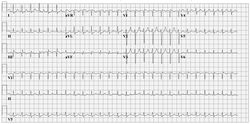AVNRT: Difference between revisions
Jump to navigation
Jump to search
No edit summary |
mNo edit summary |
||
| Line 16: | Line 16: | ||
Two sensitive characteristics to identify AVNRT on the ECG are: | Two sensitive characteristics to identify AVNRT on the ECG are: | ||
* R'. This is a small secondary R wave. It resembles a [[ | * R'. This is a small secondary R wave. It resembles a [[RBBB|right bundle branch block]], but the QRS width stays < 120ms. | ||
* RP << 100ms. The distance between the R and P waves is less than 100ms. | * RP << 100ms. The distance between the R and P waves is less than 100ms. | ||
{{clr}} | {{clr}} | ||
Revision as of 10:40, 13 November 2008
| This is part of: Supraventricular Rhythms |
An AV Nodal Re-entry Tachycardia (AVNRT) is a rapid tachycardia with a typical frequency around 200 bpm. The tachycardia origin is the AV node. A prerequisite for AVNRT is a slow and fast pathway in the AV node, most often caused by degradation of the AV nodular tissue. The dual pathways facilitate re-entry.
Two sensitive characteristics to identify AVNRT on the ECG are:
- R'. This is a small secondary R wave. It resembles a right bundle branch block, but the QRS width stays < 120ms.
- RP << 100ms. The distance between the R and P waves is less than 100ms.

